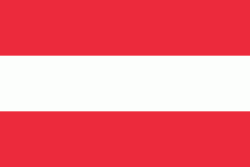Burgau (Burgau)
Burgau is a municipality in the district of Hartberg-Fürstenfeld in Styria, Austria. It is in the south-east of the country, near the border with Hungary.
The castle was originally surrounded by a water trench which gave the name to the village "Burg in der Au" ("Castle in the Meadow"). The fortification was of great strategic importance against ongoing Turkish and Hungarian invasions from the East across the nearby Lafnitz river. The castle was first mentioned in 1367 as a property of the lords of Puchheim. Then the municipality and the castle were given as a feoff to the house of Neitberg before being handed over to Weikhard von Polheim. Thanks to newly built fortifications commanded by Erhard von Polheim, the invading Turks could be defied in the years 1529 and 1532. In the end, the indebted property of Burgau was given to Mathias von Trauttmannsdorff, who oppressed the local population with high socage fees. In 1704, Eastern Styria was heavily devastated by attacking Kuruz, Hungarians rebelling against the Habsburgs. The mayor saved the village by offering weapons and money to the invaders.
In 1753 the Hungarian aristocrat Adam Count Batthyány purchased the property from the Trauttmannsdorff family. The Batthyány family contributed to an economic boom in Burgau. The first cotton spinning mill in the Habsburg monarchy was built in 1789. Two modern spinning machines had been smuggled into the country from England. After the war against France the factories had to be closed but were reopened in 1831 by Viennese merchant Georg Borckenstein. Thus Burgau operated the oldest textile factory in the Danube Monarchy. In 1884 Burgau was connected to the local railway line Bierbaum-Neudau. The last owner of the castle was Count Lajos Batthyány, who was sentenced to death and killed after the 1848 revolutions. In memory of his 150th day of death, a bust and an inscription of Count Batthyány were installed in the courtyard of the castle in 1999.
Today the renovated castle houses the mayor's office, apartments and a café. The festive hall and the arcaded courtyard are used for indoor and outdoor cultural events and annual exhibitions for Christmas and Easter.
The castle was originally surrounded by a water trench which gave the name to the village "Burg in der Au" ("Castle in the Meadow"). The fortification was of great strategic importance against ongoing Turkish and Hungarian invasions from the East across the nearby Lafnitz river. The castle was first mentioned in 1367 as a property of the lords of Puchheim. Then the municipality and the castle were given as a feoff to the house of Neitberg before being handed over to Weikhard von Polheim. Thanks to newly built fortifications commanded by Erhard von Polheim, the invading Turks could be defied in the years 1529 and 1532. In the end, the indebted property of Burgau was given to Mathias von Trauttmannsdorff, who oppressed the local population with high socage fees. In 1704, Eastern Styria was heavily devastated by attacking Kuruz, Hungarians rebelling against the Habsburgs. The mayor saved the village by offering weapons and money to the invaders.
In 1753 the Hungarian aristocrat Adam Count Batthyány purchased the property from the Trauttmannsdorff family. The Batthyány family contributed to an economic boom in Burgau. The first cotton spinning mill in the Habsburg monarchy was built in 1789. Two modern spinning machines had been smuggled into the country from England. After the war against France the factories had to be closed but were reopened in 1831 by Viennese merchant Georg Borckenstein. Thus Burgau operated the oldest textile factory in the Danube Monarchy. In 1884 Burgau was connected to the local railway line Bierbaum-Neudau. The last owner of the castle was Count Lajos Batthyány, who was sentenced to death and killed after the 1848 revolutions. In memory of his 150th day of death, a bust and an inscription of Count Batthyány were installed in the courtyard of the castle in 1999.
Today the renovated castle houses the mayor's office, apartments and a café. The festive hall and the arcaded courtyard are used for indoor and outdoor cultural events and annual exhibitions for Christmas and Easter.
Map - Burgau (Burgau)
Map
Country - Austria
 |
 |
| Flag of Austria | |
Austria emerged from the remnants of the Eastern and Hungarian March at the end of the first millennium. Originally a margraviate of Bavaria, it developed into a duchy of the Holy Roman Empire in 1156 and was later made an archduchy in 1453. In the 16th century, Vienna began serving as the empire's administrative capital and Austria thus became the heartland of the Habsburg monarchy. After the dissolution of the Holy Roman Empire in 1806, Austria established its own empire, which became a great power and the dominant member of the German Confederation. The empire's defeat in the Austro-Prussian War of 1866 led to the end of the Confederation and paved the way for the establishment of Austria-Hungary a year later.
Currency / Language
| ISO | Currency | Symbol | Significant figures |
|---|---|---|---|
| EUR | Euro | € | 2 |
| ISO | Language |
|---|---|
| HR | Croatian language |
| DE | German language |
| HU | Hungarian language |
| SL | Slovene language |















